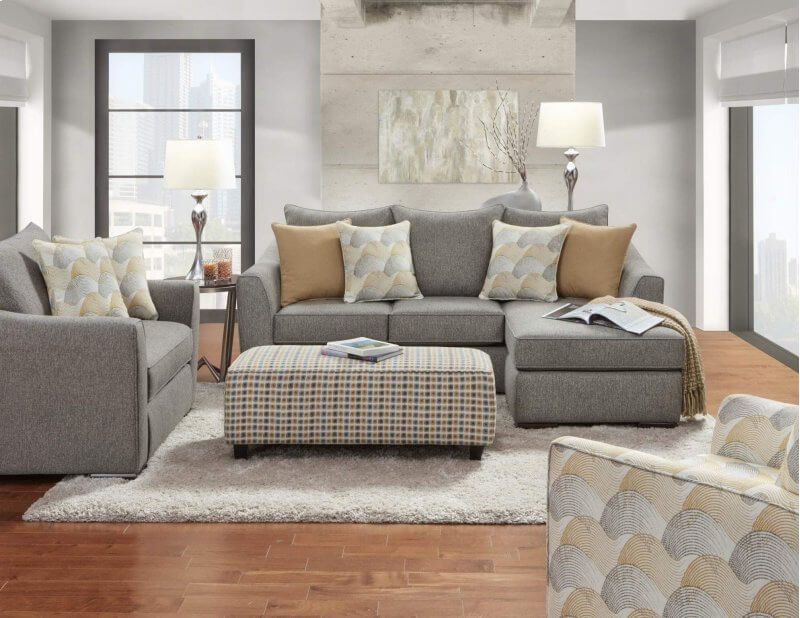
Regularly vacuuming your upholstered furniture is the single best way to keep it looking new. In the case of a liquid spill, blot the spill immediately with white cotton or tissue. Soiled areas should be vacuumed and then cleaned with either a solution of warm water and a mild detergent and a 100% cotton cloth; or with a mild solvent. Product tags usually contain furniture care and cleaning recommendations. Pre-testing is always advised.
Excessive sun exposure is guaranteed to destroy furniture. It can cause leather and vinyl to fade, dry out or crack. Dust, which acts as a mild abrasive, greatly increases the rate of wear. Natural oils, acids, and moisture produced by the skin, as well as body lotion and sweat, will be absorbed by any cover potentially staining the cover. Body oil and sweat will cause vinyl and leather to harden and crack. This damage cannot be repaired.
Seat cushions should be turned over regularly and moved around so they will wear evenly and keep their shape. Sitting on the same seat will cause it to wear differently than the rest. Zippers are used on cushions for a better fit, and their presence is not an indication that covers should be removed for cleaning. NEVER put cushion covers in the washing machine. Tighten string buttons by turning clockwise; loosen by turning counterclockwise.
These fabrics are excellent when it comes to stain resistance. To keep it looking its best, we suggest vacuuming regularly to remove dust and dirt. Be sure to clean spills up immediately to prevent liquids from soaking up in the material or cushions. Soak up any liquids with a light blotting technique and try not to rub with pressure. You will also want to occasionally deep clean your sofa with a water-based cleaner, be sure to check the tags for any specific furniture care instructions. We also suggest brushing your sofa, microfiber material can become slightly stiff if the tiny fibers become entangled. Brushing the fabric will liven it back up.
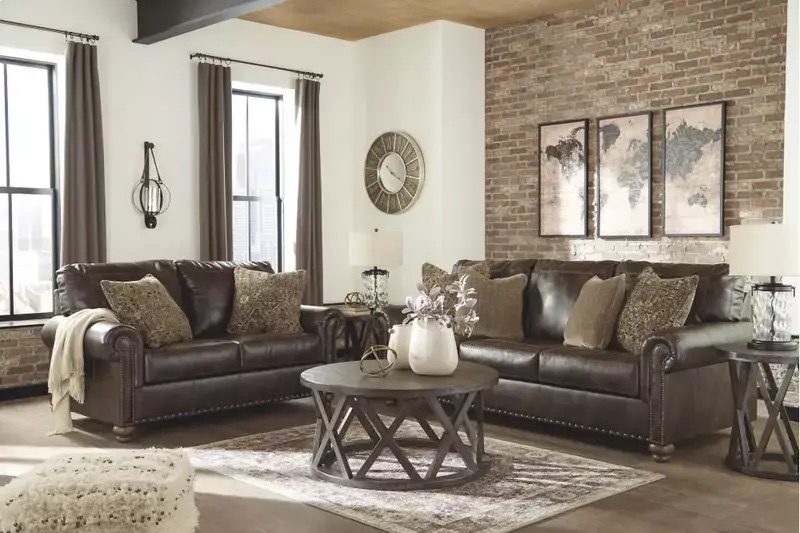
All leather has natural markings, including variations of shade and tone, nicks, scratches, and wrinkles that only occur in genuine leather. These characteristics distinguish genuine leather from man-made materials. Some marks which will appear on the surface of your leather are healed scratches, barbed wire marks, wrinkles and insect bites and are in no way to be considered a defect. Grain patterns and the color of the leather will vary from hide to hide and also within the same hide. These natural markings will not affect the durability or construction of your piece but is your assurance that you have a true leather hide.
Blot any spills immediately; do not rub. To remove a spot, use a furniture care solution of ½ mild soap (Neutrogena) and ½ distilled water on a slightly dampened cloth or sponge. Rinse by blotting with distilled water. Blot to remove excess water. For difficult stains, contact a professional cleaning service
Dust regularly and wipe with a slightly dampened soft cloth. Do not rub strongly. Leather needs gentle care. Every month use a leather conditioner to keep your leather clean and supple. Leather conditioner is like a moisturizer for your skin. It helps preserve your leather furniture.
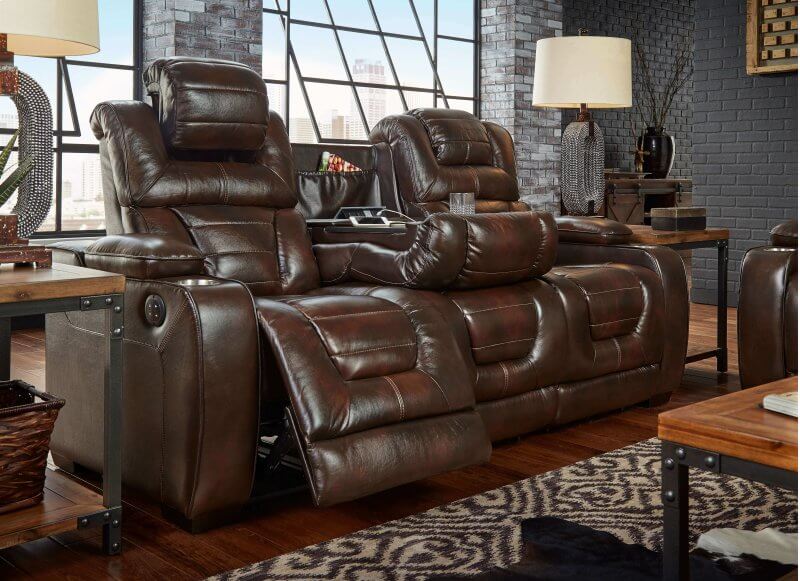
With proper furniture care, your recliner will give you many years of enjoyment. Recliner mechanisms are typically tested for twenty-five thousand cycles of opening and closing.
Always sit down gently on the recliner. When sitting upright in the chair, always engage the reclining mechanism using firm and smooth pressure. When returning the recliner to the upright position, lean forward using your calves to retract the footrest while also pushing the handle forward. Make sure that all four legs of your recliner are level and securely touching the floor. Floors tend to be uneven especially near walls. Call the store at the first sign of a problem. The old adage, "A stitch in time saves nine," applies here.
Never allow a child to climb onto your lap or feet while in the reclined position. This may bend the mechanism. Unsupervised children and recliners do not mix. Keep children and their hands away from the interior moving parts. Never lean sideways when you are in the reclined position. The tendency here is to push off the footrest, which could cause damage. Never stand up without completely closing the mechanism. When moving the chair, never grab, hold or pull by the footrest. Carry the chair from the base.
If the power stops working, check the following:
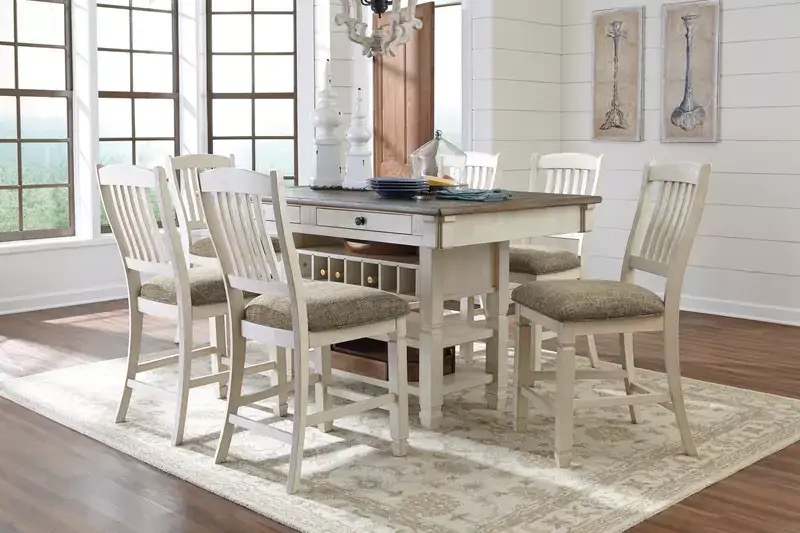
Dust wooden surfaces weekly with a damp cotton cloth. Window cleaner may be used on plastic laminates—never use window cleaner or other household cleaners on wood surfaces! A slightly damp cloth with just water works best. Use a lint-free cloth to polish on a weekly basis. Keep furniture away from heating and air conditioning sources to prevent loss of moisture. Use felt backing on lamps and other accessories to prevent scratches and gouges. Use placemats under plates and hot pads under serving dishes. Use coasters under all beverages. Do not use abrasives or harsh chemicals on wood furniture.
For opened grained woods, use beeswax formulations such as "Howard's™" For finished surfaces with covered wood grains, use a non-silicone, lightweight wax/polish such as those sold in grocery stores. DO NOT OVER-WAX OR OIL. Modern finishes do not require continual polishing.
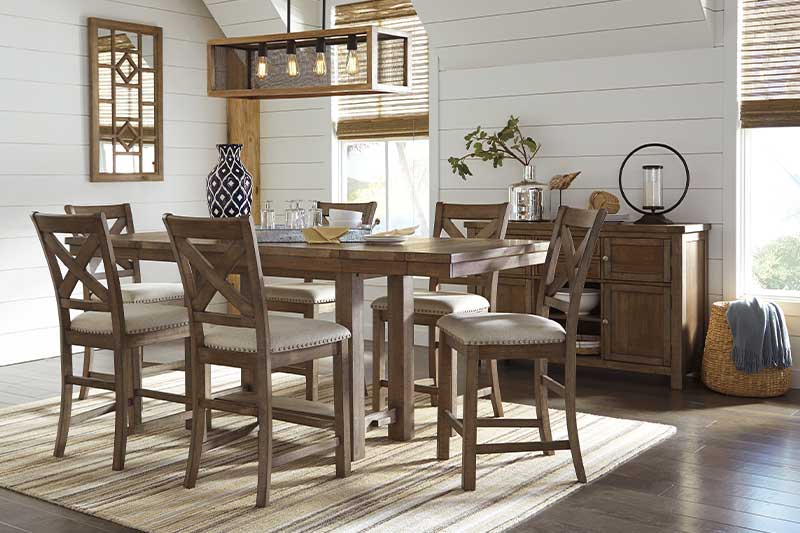
With care, a dining table will last for many years. The following are some good guidelines to remember.
With extension tables, it is important to ensure that moisture does not remain in the seams of the table top after use or cleaning. Prolonged moisture exposure may destroy the finish and ruin the core of your table. Do not leave unbreathable plastic coverings on wood dining tables for prolonged periods. Plastic will trap moisture (even moisture from humidity) and damage the wood. Never leave standing water, glasses containing chilled liquids or hot containers on the table. This kind of neglect can cause moisture rings, veneer lifting, finish checking, or crazing. Your table is not guaranteed against moisture damage due to neglect.
Never lean back in your chair or barstool. Serious injury can result from a fall and your chairs and/or barstools were designed to properly support you when all four legs are securely touching the floor.
Proper maintenance includes periodic tightening of any screws or bolts to the legs of your table and chairs/barstools. These may become loose under normal usage and wear and tear. This is normal. If you fail to tighten them you might crack or break the legs and this is not covered under the manufacturer’s warranty.
To level your table, first check and see if the legs have levelers attached. If it does not, loosen the screws or bolts on the legs, press firmly down on the table, then tighten the screws or bolts.
Inserting and removing the leaves of a table requires two people—one at each end. When inserting a leaf, place the leaf over the table runners so that the pins and holes match up correctly. In addition use the wood's grain to properly arrange the leaves. Occasionally, the bottom of the table will have chalk lines and numbers that indicate the correct order. Then from both ends of the table, gently push the table together. If the table is sitting on carpet, lifting up on the table reduces the stress placed on the leg joints, which can be damaged. Pushing can damage the legs.
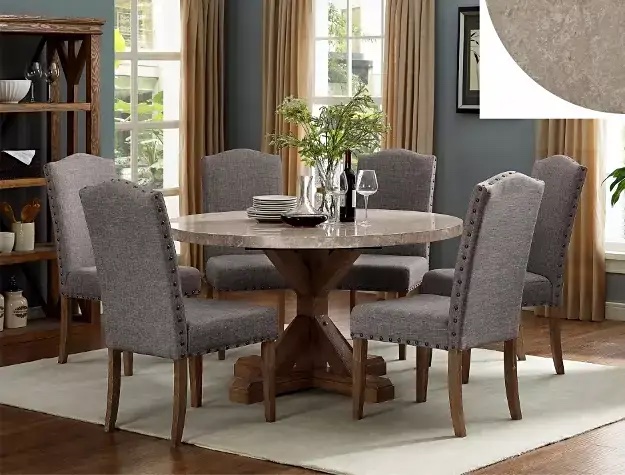
Stone, including marble, slate, granite and travertine, is quite durable but should not be treated as indestructible. These beautiful materials are quarried from all over the world. Every region is unique in color, veining, pits and seams. These are hallmark characteristics of a natural material. From piece-to-piece, and even on a single quarried slab, there will be color variations. Stone surfaces will have pits and fissures that appear as cracks. They result from immense heat and pressure, which formed the stone eons ago. These characteristics are part of the natural beauty and do not impair the function or durability of the material.
Use coasters under glasses, especially if they contain alcohol or citrus juices. Use trivets or mats under hot dishes or cookware. Use placemats under china, ceramics, silver or other objects that may scratch the stone surface. Clean with warm water. Dip sponge or clean cloth into the water. Wring out excess liquid as much as possible. Wipe surface. Dry surface immediately after cleaning. Do not use vinegar, bleach, ammonia or other general-purpose cleaners.
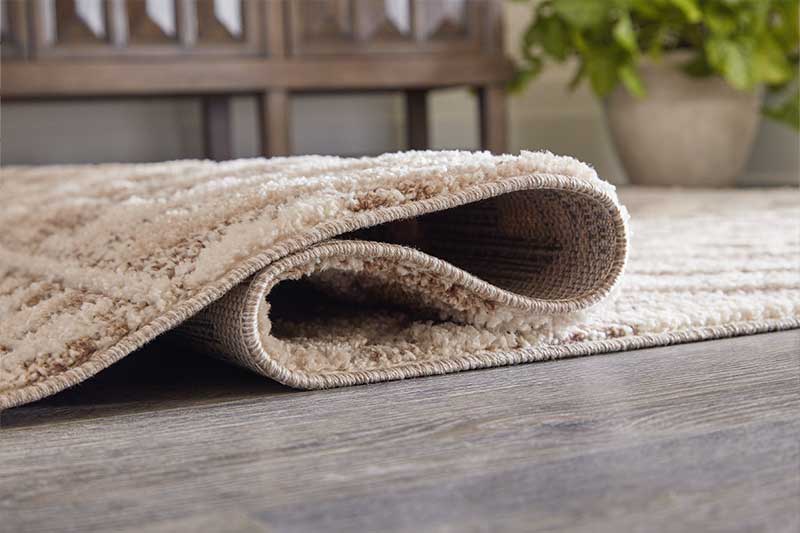
Vacuum regularly on the lowest-level suction. Avoid fringe trim to prevent accidental fraying. Rotate on a regular basis to evenly distribute wear. Professionally clean once a year to remove any stains.
If a spill occurs, clean immediately. Blot with a clean, absorbent white cloth. Do not rub. Many stains can be gently removed by using club soda and a small amount of carpet cleaning detergents.
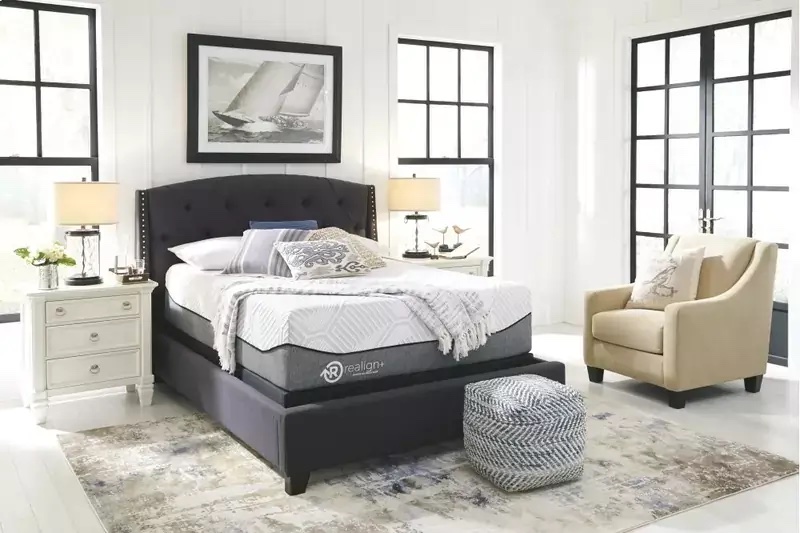
You need one. Buy online or in store if you do not already have one.
A good quality, washable mattress protector will keep your mattress dry and free from stains which can invalidate your warranty. We recommend the use of a waterproof mattress protector if your household has children or pets.
Let your mattress air out. New product odor will dissipate with time. To help speed up the process you can air out your mattress prior to putting on your sheets. Provide a proper foundation. A new mattress needs a strong foundation beneath it. Failure to use a proper foundation (box spring) could lead to damage, unsatisfactory performance or reduce the life of your mattress. Rotate your mattress.
Don’t use chemicals to wash your mattress. Chemicals used in spot removers or dry cleaning agents may harm the fabric or materials. To clean a stain, use mild soap and water and apply sparingly. We recommend vacuuming annually to keep your mattress fresh. Don’t jump on your mattress. Walking on or jumping on your mattress or box spring can damage the construction and can cause injury to yourself or others. Don’t remove the law tag. The information located on this tag will serve as a means of identification should you have a warranty claim. Don’t bend your mattress. To get a mattress through a doorway or around a corner you may flex the mattress but it should never be folded or sharply bent. Carry your mattress upright. It is easier to handle and less likely to be damaged.
Keep in mind, if you’ve purchased the Guardian Plan (Oops Proof) any stains or damages must be reported within the first 5 days of the incident. Contact us to file a claim.
S - Spot clean only with a water-free dry cleaning solvent. Pretest a small, inconspicuous area before proceeding. Do not saturate. DO NOT USE WATER. Pile fabrics may require brushing with a non-metallic, stiff bristle brush to restore appearance. Cushion covers should not be removed and dry cleaned. To prevent overall soiling, frequent vacuuming or light brushing with a non-metallic, stiff bristle brush to remove dust and grime is recommended. When cleaning a spill, blot immediately to remove spilled material. Clean spots or stains from the outside to the middle of the affected area to prevent circling. Overall cleaning by a professional furniture cleaning service only is recommended.
SW - Spot clean with upholstery shampoo, foam from a mild detergent, or mild dry cleaning solvent. Pretest a small, inconspicuous area before proceeding. Do not saturate. Pile fabrics may require brushing with a non-metallic, stiff bristle brush to restore appearance. Hot water extraction or steam cleaning is not a recommended cleaning method. Cushion casings should not be removed and laundered or dry cleaned. To prevent overall soiling, frequent vacuuming or light brushing with a non-metallic, stiff bristle brush to remove dust and grime is recommended. When cleaning a spill, blot immediately to remove spilled material. Clean spots or stains from the outside to the middle of affected area to prevent circling. Use a professional overall soiled condition has been reached.
W - Spot clean only with water-based shampoo or foam upholstery cleaner. Pretest for color loss and fabric compatibility. Do not over wet. Use professional upholstery cleaning service for overall soiling.
WS - Spot clean with upholstery shampoo, foam from a mild detergent, or mild dry cleaning solvent. Pretest a small, inconspicuous area before proceeding. Do not saturate. Pile fabrics may require brushing with a non-metallic, stiff bristle brush to restore appearance. Hot water extraction of steam cleaning is not a recommenced cleaning method. Cushions casings should not be removed and laundered or dry cleaned. To prevent overall soiling, frequent vacuuming or light brushing with a non-metallic, stiff bristle brush to remove dust and grime is recommended. When cleaning a spill, blot immediately to remove spilled material. Clean spots or stains from the outside to the middle of affected area to prevent circling. Use a professional furniture cleaning service when an overall soiled condition has been reached.
X - Cleaning only by vacuuming or light brushing with a non-metallic, stiff bristle brush. DO NOT USE ANY WATER OR SOLVENT BASED CLEANER.